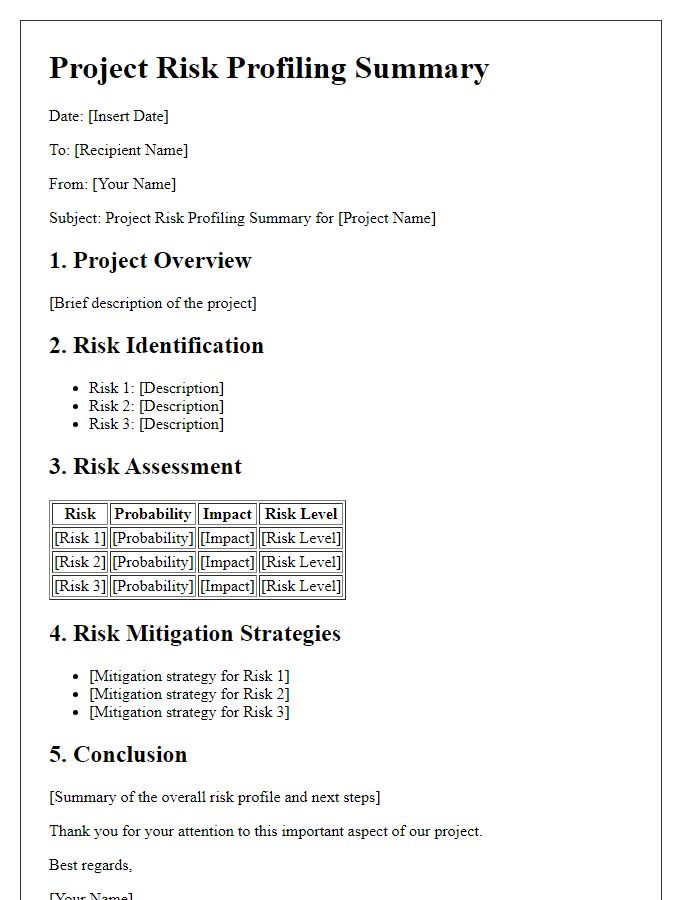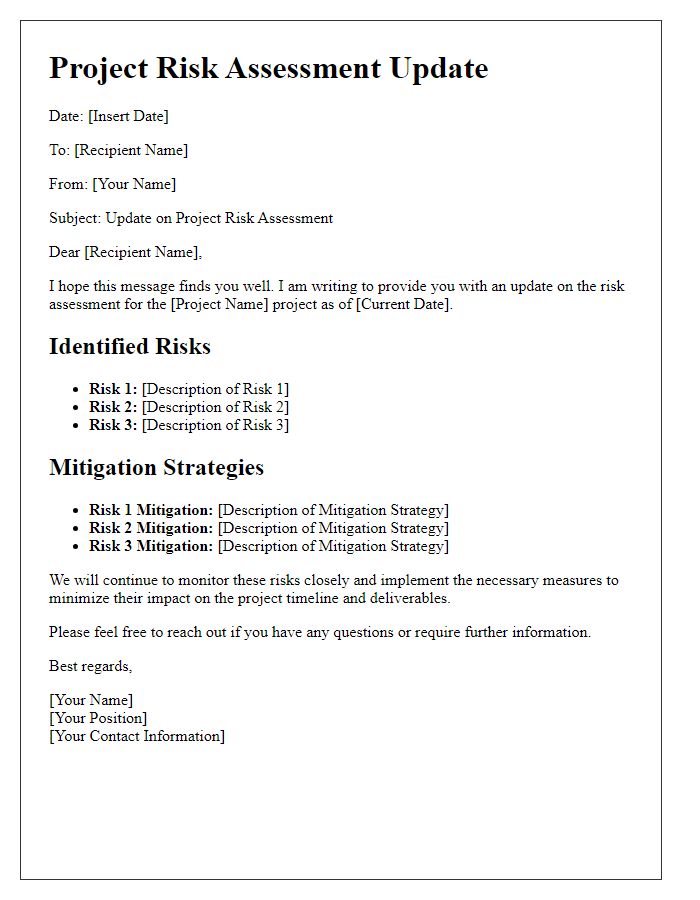Are you looking to effectively communicate project risks in a clear and concise manner? A well-structured project risk assessment summary letter can make all the difference in ensuring stakeholders are informed and engaged. With practical insights and a straightforward format, you can easily outline potential risks, their impact, and the strategies in place to mitigate them. Let's dive into the essential elements of this template, so you can craft a compelling risk assessment summary for your project!

Identification of Potential Risks
Identifying potential risks in a project is crucial for ensuring successful outcomes and minimizing disruptions. Common risk factors include market volatility, which may impact financial investments, and regulatory changes affecting compliance. Additionally, resource availability, such as skilled personnel or necessary materials, can pose challenges. Technological advancements may create risks associated with system compatibility and cybersecurity vulnerabilities, potentially jeopardizing sensitive data. Stakeholder engagement is also vital; disengagement can lead to miscommunication and project delays. Natural disasters, exemplified by recent hurricanes in the Gulf Coast region, highlight the importance of disaster recovery plans to mitigate operational interruptions. Properly assessing and addressing these risks fosters a proactive approach, contributing to the overall resilience of the project.
Assessment of Risk Impact and Probability
A comprehensive project risk assessment identifies potential risks, evaluating their impact and probability to ensure project success. Risks can include factors such as financial constraints (budget overruns exceeding 20%), timeline disruptions (delays greater than three weeks), and resource availability (shortages of critical personnel). Each risk is assigned a probability score on a scale of 1 to 5, indicating likelihood of occurrence (1 being rare, 5 being highly likely). Simultaneously, impact scores (1 to 5) assess potential consequences on project goals, including schedule slippage, decreased quality, and stakeholder dissatisfaction. Mapping these risks on a risk matrix enables visualization of high-priority risks, guiding mitigation strategies to minimize adverse effects on project deliverables.
Proposed Mitigation Strategies
Implementing proactive risk management strategies is critical in project execution. For identified risks, such as schedule delays (occurring over 30% of projects based on PMI studies), proposed mitigation strategies include adopting Agile methodologies, enhancing stakeholder communication, and instituting regular progress reviews (weekly checkpoints). Additionally, diversifying the supplier base (reducing dependency on a single vendor by at least 20%) can mitigate supply chain disruptions associated with global events (e.g., pandemic or natural disasters). In terms of financial risks, establishing a contingency fund (typically 10-15% of the project budget) ensures preparedness for unexpected costs. Emphasizing thorough training for team members (at least 8 hours of specific skill development) will enhance their capability to manage emerging challenges effectively.
Assignment of Risk Ownership
Risk ownership in project management is critical for ensuring accountability and effective mitigation strategies. Each identified risk must have a designated owner responsible for monitoring, reporting, and addressing the risk throughout the project lifecycle. For instance, in a construction project with a budget of $5 million, the risk of budget overruns might be assigned to the project manager, who will develop budget control measures. For scheduling risks, such as delays due to weather conditions in New York City during winter months, the owner could be the operations manager, tasked with creating contingency plans. Additionally, technical risks associated with software integration might fall to the IT manager, responsible for overseeing quality assurance testing. Assigning clear ownership helps to maintain focus, increases responsiveness, and fosters a proactive approach to risk management, thereby minimizing potential impacts on project success.
Monitoring and Review Plan
A Monitoring and Review Plan is essential for project risk assessment, ensuring that identified risks are continuously tracked and evaluated throughout the project lifecycle. This proactive approach includes establishing regular review meetings--typically scheduled bi-weekly or monthly--focused on assessing risk mitigation strategies. Key risk indicators, such as project milestones and budget variances, are monitored to gauge the effectiveness of risk responses. Various tools, including risk assessment matrices and status reports, are utilized for documentation. Stakeholders, such as project managers and team members, are engaged in the review process to provide insights and updates on risk status. Continuous improvement initiatives, correcting any inconsistencies in risk management processes, are also part of this plan to enhance project outcomes.













Comments